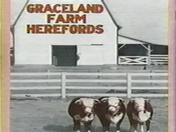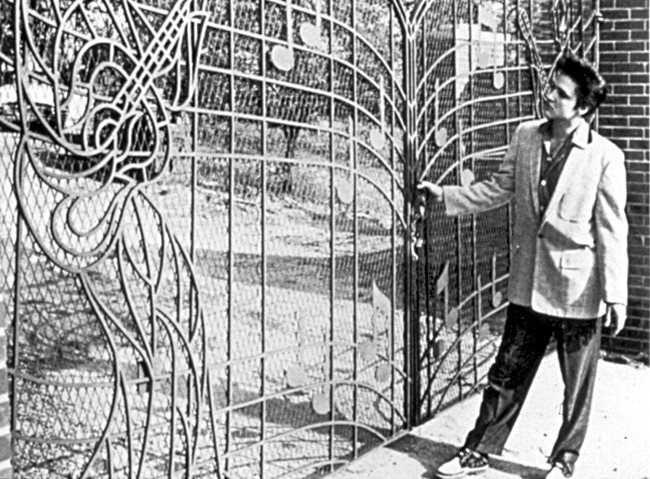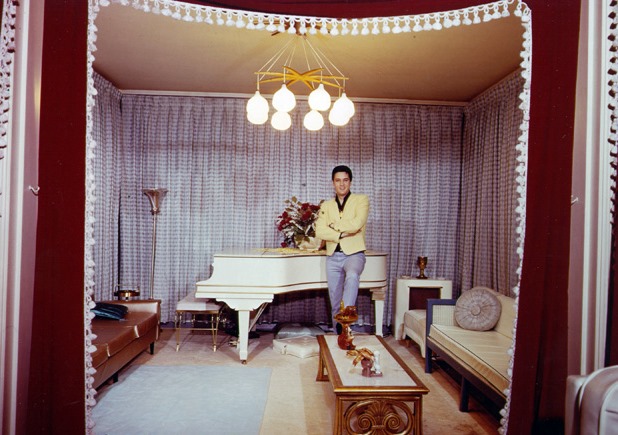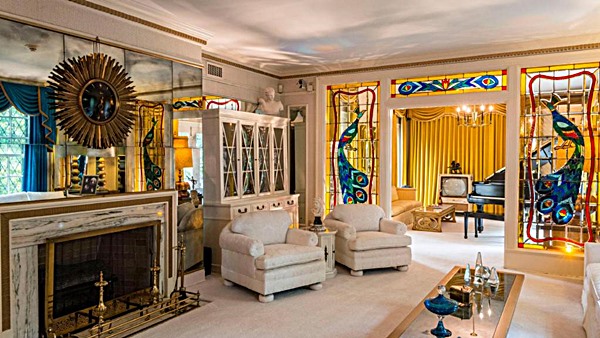All About 'Graceland':
everything you ever wanted to know about Elvis' Memphis mansion
Happy Birthday Graceland, March 25, 1957 - Graceland's 60th anniversary..
The mansion that Elvis purchased for $102,500 on March 25, 1957 for his mama, Gladys, his dad, Vernon, and himself to "stretch out in" (Elvis' words) has 23 rooms spread out over 17,000 square feet, and is situated on 13-plus acres of prime Memphis real estate.
But it's small, compared to what people expect. Small, compared to the Versailles-like palace many imagine the King of Rock and Roll to have held court in, with his "Memphis mafia," pink Cadillacs and closets full of sequined jumpsuits. Small, in other words, compared to how large Graceland looms in the popular imagination.
As Elvis fans visiting for the first time note, as far as superstar mansions go, it is very modest in terms of size. |
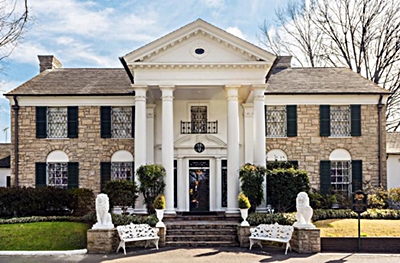 |
But size isn't everything. And Graceland's relatively modest footprint hasn't deterred thousands of annual visitors from turning the Elvis mansion into the second most visited residence in the US (White House is No. 1).
Graceland has become an inspiration, a symbol, a byword. When Bruce Springsteen was anointed the new king of rock and roll after the release of "Born to Run" in 1975, it was only natural that he'd celebrate by jumping the iconic music-note gate at Graceland at 3 a.m., seeking an audience with the reigning monarch. (Guards escorted him to the sidewalk.)
When Marc Cohn went "Walking in Memphis" in his 1991 hit, it was a foregone conclusion that he would end up at Graceland: "Saw the ghost of Elvis, On Union Avenue, Followed him up to the gates of Graceland, Then I watched him walk right through." Most notably, Paul Simon's Grammy-winning 1986 album "Graceland" used the Elvis mansion as a jumping-off point for a whole odyssey about race, class, homelessness and identity. It goes beyond the house. There's an aura, because of who lived in it."
|
 |
Graceland was named after Grace Toof, the daughter of Memphis printer Stephen C. Toof, founder of S.C. Toof & Co., whose namesake grounds and mansion, built in 1939, Elvis Presley bought when he was seeking refuge from his hordes of fans.
But such is the power that Graceland has assumed in the popular imagination, 40 years after Elvis' death on Aug. 16, 1977, that it has come to encompass all meanings.
The mansion graced for 20 years by the King of Rock and Roll himself, and finally Graceland the shrine, the place where, since it was opened to the public in 1982, 650,000 pilgrims arrive each year to seek the blessings of the great god Elvis.
|
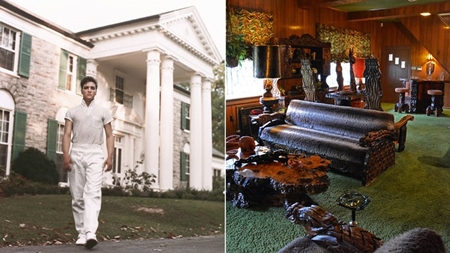 |
"I have reason to believe we all will be received in Graceland," Paul Simon sang, knowingly. His use of the word "received" is the tip-off. Substitute "heaven" for "Graceland", "I have reason to believe we all will be received in heaven", and you have the basic promise of the Christian church.
So what is the grace that visitors seek at Graceland?
It isn't graceful living, at least in any sense that Better Homes and Gardens would recognize. Elvis was many things, but he was not an interior decorator. The famous "Jungle Room" with its tiki bar furniture, fake waterfall and colored lights, is not exactly a byword for tasteful restraint. The all-white living room with its peacock-stained glass windows, the billiards room with its outrageous sunburst ceiling and Tiffany-style lampshades, is something no self-respecting mobster would be seen in.
The gaudy decor, in fact, may be a key to the place that Graceland holds in the American imagination.
Elvis Presley was a dirt-poor Mississippi boy from Tupelo. From sheer determination, force of character, and talent - lots of talent - he made himself into a wealthy pop star, the idol of millions. His mansion reflects how a poor boy from Mississippi might imagine rich people lived.
Rich Elvis was exactly the same as poor Elvis - one of the reasons so many people loved him. When Presley came into millions, he didn't suddenly switch from beer to fine wine, develop an interest in Chippendale furniture, hobnob with senators or obsess about which fork to use. He still hung out with the same good old boys he grew up with, and horsed around the way he did in high school. To the end of his life, he lived the way a 17-year-old country boy who had suddenly come into lots of money would live.
When you walk through Graceland, you imagine a scene in Elvis' life, picturing what he might be doing. The only thing is fans always wish they could go upstairs. It seems so off-limits. Just to see the bedroom. Crushed velvet, perhaps. Mirrors. But maybe Graceland isn't a shrine to Elvis after all. Maybe it's a temple to our most sacred idea: The American Dream.
As the class divide in the United States gets more conspicuous, as the traditional routes to achievement become blocked, more than ever we seek tangible proof that it is still possible to rise in this country, that one day it could be us driving that pink Cadillac, living in that mansion with the white columns, or even issuing directives from the Oval Office.
The American Dream, like all beliefs, is impalpable - abstract. But since March 25, 1957, it's had a concrete address: 3764 Elvis Presley Blvd. (formerly Highway 51 South), Memphis.
Graceland. Where we all will be received.
We need our mythology. People go to Graceland because Elvis represents the American dream. The guy who came from nothing, and shook his behind to the top of the world. |
|
Graceland, before Elvis: Farm filled with family memories: Ruth Cobb is one of the few people outside Elvis Presley's family to visit the upstairs of Graceland.
It was before it opened as a tourist attraction, and Cobb, who lived there before Elvis, soon learned her old upstairs bedroom had been turned into a music room.Cobb visited in 1967 at the invitation of Elvis' grandmother, and later when the Presley family planned to turn the home into a tourist attraction. It reminded Cobb of her own music career and left her slightly quizzical about a few decorating changes. |
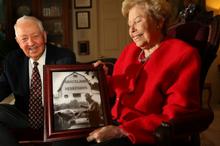 |
"We did not have a jungle room growing up," she says. There was also no fabric on the ceiling of the billiard room in her day. "We didn't have a billiard room," she says.
Other distinctive touches added during Elvis' ownership of Graceland drew little attention from Cobb, but there was one: "Elvis didn't like the chandelier we had in the dining room. It came from New Orleans. He put up some garish thing."As part of this week's observations of Elvis' birthday, Graceland is celebrating its 70th anniversary, and mementos of its early years are part of a new tour.
Cobb, 82, and her husband, retired lawyer Charles Cobb, 86, married in 1948. She had grown up at Graceland as an only child. When she married Charles Cobb, they remained at Graceland with her parents at first while Ruth toured the country as part of a professional harp ensemble. She would later become harpist for the Memphis Symphony Orchestra from 1953 to 1973.Her father, Dr. Thomas Moore, was a prominent surgeon and urologist. Her mother, Ruth Brown Moore, was a volunteer who enjoyed club work and became president of the Tennessee Association of Garden Clubs.They built Graceland in 1939, naming it for Ruth's great aunt, Grace Toof, who had left the farm to Ruth's grandmother. The grandmother divided her 520-acre farm into three parts, leaving it to her three children. Two of them sold their shares to Ruth's father.
The house on 20 acres began as what Ruth Cobb calls "just a comfortable country home." It would become as familiar to America as Tara, Scarlett O'Hara's home in "Gone With the Wind," and it would rival Monticello, Mount Vernon and other once-private homes among the biggest tourist attractions in the country.
There, Ruth's father taught her to shoot well enough that she once downed three geese with a single shot. He also taught her to fish in a 25-acre manmade lake behind the house. But her first love was music. Ruth played the piano, but she loved the harp, studying, then touring with one of the world's leading harpists, Carlos Salzedo.Her favorite music was classical, but Ruth says she liked all music from country to Elvis' music.
"I wasn't really crazy about his music, but my mother marveled at his hymns," she says. When her mother decided the property was more than she wanted to keep up, she asked Ruth and Charles if they would like to stay.
"We just didn't have time to take care of a big house," says Charles. "It cost $1,000 a month to keep it up. The yard alone was like trying to take care of a golf course. We had a yard man who worked two to three days a week.
"When the property was put up for sale, Ruth said there were three potential buyers -- Sears Roebuck Co.; a private party who wanted to turn it into an exclusive restaurant, and Elvis. By then, most of the surrounding land had been sold to developers for a subdivision, and the lake behind the house had been drained.
Ruth says a church, Graceland Christian Church, wanted to buy 5 acres on the northwest corner of the property. Sears and the restaurant interests did not want to split the 5 acres off for the church, but Elvis said he would be glad to have a church next door, she says. That helped seal the deal. Elvis bought the property for $102,000 in 1957.
When the church next door, Graceland Christian Church, eventually decided to move, the Presley family bought back the land and turned the church into the headquarters of Elvis Presley Enterprises.
Ruth and Charles built their own home in Coro Lake and later moved to Central Gardens before retiring to Trezevant Manor.Charles met Elvis during the closing on the sale of Graceland, but Ruth never met him. She has since returned to Graceland as a tourist with her grandchildren. "I thoroughly enjoyed it, but it didn't feel like home," she says. (News, Source: Michael Lollar, Commercial Appeal Online, 8 Jan 2009)
All
About 'Graceland': everything you ever wanted to know about Elvis'
Memphis mansion
by
Nigel Patterson, July 2004
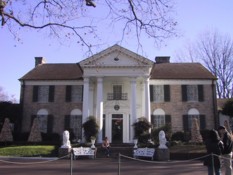 |
3764
Elvis Presley Boulevard (formerly known as South Bellevue
Road/Boulevard), or Graceland as it is more widely referred
to, sits atop a hill in the suburb of Whitehaven, Memphis
on U.S. Highway 51. It is around 8 miles south of downtown
Memphis and the grounds stretch across 13.8 acres.
Whitehaven
was originally an unicorporated part of Memphis. It was later
annexed by the city of Memphis.
|
Quote: "Graceland looked like the country place that showcased Lana Turner
in the 1959 tearjerker, Imitation of Life", (Professor) Karal Ann
Marling in Graceland: Going Home With Elvis.
The
Graceland property was originally established as a 500 acre farm
during the American Civil War (1861-1865) by publisher S.E. Toof
(owner of the Memphis Daily Appeal). Toof named the property after
(depending on your source) either his daughter, Grace Toof or an
auntor niece named Grace (perhaps all).
The
present mansion (actually a Southern colonial mini-mansion) known
as Graceland was built 1939 by Dr. Thomas and Ruth Moore. Mrs Moore
was the niece of Grace Toof. The property was later sold by the
couple's daughter, Ruth Marie, herself to later become a celebrated
harpist with the Memphis Symphony, to (another) musician, Elvis
Aaron Presley. (Today, it is the property of Lisa Marie Presley
under the terms of Elvis' will).
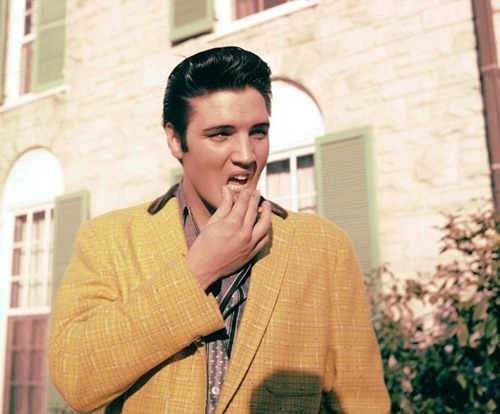 |
Elvis had outgrown the nice home he enjoyed on Audubon. It was a good home, but his neighbors complained about the seemingly constant stream of fans and the family’s chickens, which lived in the yard (things that never bothered Elvis). Elvis considered buying every neighboring house, but instead, he and his parents decided to find a larger home out in the country.
On Saturday, March 16, 1957, Elvis’ parents, Gladys and Vernon, took a tour of Graceland, which was a bit more secluded than the Audubon home. It sat high up on a hill off Highway 51, not far from the Mississippi-Tennessee State line.
The Presleys fell in love with the home, which had been built in 1939 by the Toof family. Named Graceland after the owners’ aunt, Grace, the beautiful, two-story home was exactly what they were looking for in a home for their family. They called Elvis, who was filming in Hollywood, and told him the good news.
Elvis arrived in Memphis on March 18, and the next day, he put a $1,000 down payment on the home. The purchase was finalized on March 25 for $102,500.
It
was being used by the Graceland Christian Church for prayer services.
Elvis was fortunate to get Graceland as it had already been sold
to the YMCA for US$35,000 when he saw it. By upping the price significantly
Elvis finally obtained his "home".
Elvis paid $10,000 in cash, received $55,000 from the realty company for the Audubon Drive home and got a 25-year mortgage for the remainder. Elvis purchased the home as well as 13.8 acres of the surrounding farm land.
The Presley family had Graceland renovated before moving in, so Vernon, Gladys and Elvis’ grandmother didn’t move in until May 16. Elvis was filming “Jailhouse Rock” by this time, so he didn’t spend the first night there until June 26.
The famous Graceland gates were one of the first major changes Elvis made to the property.
Quote: "Elvis' house has balls." Michael St. Gerard, actor who played Elvis
in 'Elvis" on ABC
The
two-story mansion is constructed of Tishomingo or tan Tennessee
limestone and the number of rooms it houses has varied between eighteen
or twenty-three, including five to eight bedrooms and up to eight
bathrooms. Corinthian columns form the entrance portico.
Elvis
painted the mansion blue and gold, which glows at night. The painting
was undertaken by C.W.Nichols. It turned out Nichols was not a member
of the local painter's union, and Graceland was picketed by Painter's
Local #49. Renovations over the years have seen Graceland grow from
10,266 square feet to 17,552 square feet. While Elvis liked redecorating,
his parents added their own touches:a
vegetable garden and a chicken coop.
Elvis
and his parents called Graceland home from 1957 for the remainder
of their lifetimes. Also resident at Graceland was Elvis' maternal
grandmother, Minnie Mae Presley, who outlived her son, daughter-in-law
and grandson, passing away on May 8, 1980 at the age of 86. Vernon's
sister, Delta, also lived at Graceland for a number of years.
The
front room features a white marble fireplace and Louis XIV furniture.
After buying Graceland, Elvis added several rooms including a trophy
room and racquetball court. In addition, Elvis erected a pink Alabama
fieldstone wall around the property and also the famous wrought-iron,
guitar gates at a cost of $3,052. The stone wall around Graceland
is periodically cleaned with a pressurized water system so that
fresh graffiti can be left by visiting fans.
The
trophy room was originally used by Elvis and the Memphis Mafia to
race slot cars. It would later become a tribute to Elvis' incredible
international success, showcasing his countless gold and platinum
awards, other awards and a selection of his spectacular clothing.
The Jungle Room features an indoor waterfall and houses three air
conditioners that were used by Elvis to keep the room at a less
than tropical temperature.
Did
you know?: When Gladys Presley died in 1958 Elvis hesitated
to replace a windowpane accidentally broken by his mother shortly
before her death.
While
Elvis loved redecorating and changing things, he was reluctant to
change things that reminded him of his mother. Along with Elvis,
Gladys and Vernon Presley, Minnie Mae is buried in the Meditation
Garden at Graceland. The Meditation Garden also features a grave
marker in memory of Elvis' still-born twin brother, Jesse Garon.
The Meditation Garden was built by Elvis in the mid-sixties as a
place for contemplation. The bodies of Elvis and Gladys were moved
from Forest Hill Cemetery following security threats. At
one stage a group of men tried to steal Elvis' coffin from the Cemetery.
The bodies were reinterred in the Meditation Garden on 2 October,
1977.
The
Garden's centerpiece is a circular twelve-foot fountain pool with
five single jets of water and a larger one in the middle all lit
by colored floodlights. The curved wall behind the fountain is made
of Mexican brick with four stained-glass windows.
Near
the Meditation Garden is Elvis' kidney-shaped swimming pool. When
Elvis lived at Graceland it went through several color changes.
In 1977, at the time of Elvs' death, the mansion was in its spectacular
red period. This was the result of Elvis' last redecorating spurt
in 1974. There were red carpets, red walls, red drapes, red was
everywhere.
After
Elvis' death, Graceland was valued at US$350,000. Because of an
annual upkeep bill estimated at $500,000, the mansion was opened
to tourists by Priscilla Presley on June 7, 1982.
Touring
Graceland: The mansion tour starts as fans board a shuttle bus
to take them across the highway and up the windy driveway to the
front steps of Graceland. As part of the tour, visitors can view
those parts of Graceland Elvis would have shown his friends: the
music room, the dining room, the TV room (with its three television
sets along one wall), the billiard room, the kitchen and the jungle
room where Elvis recorded parts of the Moody Blue and From Elvis
Presley Boulevard albums.
Upstairs
at Graceland: For various logistical reasons the upstairs part
of Graceland is not open to the public. There is a symbolic significance
in this. Even when Elvis was alive, the upstairs area was regarded
as The King's inner sanctum, with the stairs representing the dividing
line between it and the rest of the world.
The
upstairs area consists of Elvis' bedroom, bathroom, wardrobe room,
and office, as well as Lisa Marie's white and gold bedroom and bathroom
and a bath and dressing area used by Elvis' girlfriends.
Did
you know?: There was a glimpse of the upstairs area of Graceland
in the biographical film, This Is Elvis.
Visitors
use headsets to listen to the guided tour (originally the tour used
actual tour guides, but these were discontinued as part of a cost-cutting
exercise in the late 1990s). Apart from touring the mansion, visitors
can also visit the:
- Elvis
Presley Automobile Museum;
- Sincerely
Elvis Museum;
- take
the Lisa Marie and Hound Dog II tour; and
- watch
the film Walk A Mile In My Shoes.
The
mansion is visited by up to 700,000 visitors each year, and as a
home in the US is second only in visitor numbers to the White House.
Tickets
to attractions are sold either individually or as packages.
Current
ticket prices are available by visiting the official Elvis web site
at: www.elvis.com
Did
you know?: The barn in the fields behind Graceland was used
to house Elvis' horses until his horse buying spree got too much
and he had to buy the Circle G Ranch. Descendants of some of the
original horses still lived in the fields behind Graceland in the
late 1990s.
Elvis
Tribute Week: The city of Memphis comes alive each August as
the annual Elvis Tribute Week is celebrated. Tens of thousands of
fans and the media from around the world converge on Memphis to
visit Graceland and enjoy the 50 or so organised events based around
the King of Rock and Roll.
Famous
Visitors to Graceland: The official Elvis web site includes
details of the long list of famous people who have visited Graceland
over the years. The mansion is celebrated in the Paul Simon recording
of the same name, and two noteworthy visitors over the years have
been Bruce Springsteen and Jerry Lee Lewis.
Springsteen
has the distinction of, before he became a star, jumping the wall
at Graceland to see The King, only to be ejected by the security
guards. As it turned out Elvis wasn't home at the time. Jerry Lee
Lewis' visit is more notorious. "The Killer", one of the wild men
of rock & roll turned up drunk, firing a gun, and demanding to see
Elvis. Again, Elvis was not home at the time.
Graceland
Visitor Center: across from Graceland are various retail outlets
owned by EPE that market officially licensed Elvis items. (Close-by,
at 3727 Elvis Presley Boulevard is the Graceland Crossing Shopping
Center consisting of Elvis shops not affiliated with EPE).
Sources:
- All
Shook Up Elvis Day-By-Day 1954-1977, Lee Cotten
- "E"
is for Elvis, Caroline Latham & Jeannie Sakol
- Elvis
and You The Pleasures to Being An Elvis Fan, Lara Victoria Levin
& John O'Hara
- Elvis
His Life from A-Z, Fred L. Worth & Steve D. Tamerius
- Graceland:
Going Home With Elvis, Karal Ann Marling
- Last
Train To Memphis The Rise of Elvis Presley, Peter Guralnick
- Memphis
Elvis-Style, Cindy Haxen & Mike Freeman
- Roadside
Elvis The Complete State-By-State Travel Guide for Elvis Presley
Fans, Jack Barth
- The
Complete Idiot's Guide to Elvis, Frank Coffey
Click
to comment on this article
March 2017 - Elvis Presley’s Graceland a sight to behold: The Australian travel magazine featured an article on a private tour of Graceland.
It includes.. “What do you give Elvis Presley for Christmas?” George Klein wonders aloud as he stands on the precipice of Graceland’s lavish loungeroom, at the very spot where, more than 60 years ago, he was confronted with one of life’s more enviable dilemmas.
My visit is early on a Monday evening, and Graceland, Elvis’ beloved home in Memphis, Tennessee, is closed. The crowds of devoted fans and curious onlookers have left for the day and staff are busy clearing the capacious grounds. But the lights are still on inside Graceland, where the singer’s school friend, 81-year-old Klein, is leading us on a private after-hours tour. About 600,000 visitors will this year wander through the estate, tonight, though, we have the place to ourselves.
|
 |
This is one of many high points on an unofficial Elvis trail that began days earlier on a bus journey through America’s south.
One of Memphis’s most stately buildings is the Peabody Hotel, which has stood at its downtown location since 1925. With its elaborate Italian Renaissance architecture, the hotel is famous for its resident family of ducks, which are led via a red carpet, to and from the fountain beside the hotel’s ornate bar each day.
But the hotel is also a notable site for events in Elvis’ life. It was in the beautifully maintained lobby where, with his father Vernon, he signed his contract with RCA in 1955 on Peabody stationery. And upstairs in the stately Continental Room is where he attended his senior prom in 1953, too shy to dance with his 14-year-old date. That same year, having finished high school, he walked along Union Avenue, entered the door at number 706, and for a few dollars cut his own record, singing two songs. Almost a year later, Sam Phillips from the Memphis Recording Service / Sun Studio where Elvis had cut the songs, was looking for new talent. At the urging of a colleague who had heard Elvis sing, Phillips had him return for an audition. On July 5, he recorded That’s All Right.
Despite the enormous impact the events that took place there would have on the history of rock ’n’ roll, Sun Studio is a comparatively small space. Still operating as a recording studio on many nights, by day it is a wonderful site to tour, and its upstairs displays include a recreation of the studio from where Dewey Phillips played That’s All Right endlessly on that July night in 1954, and from where Elvis gave an impromptu on-air interview that evening.
Downstairs in the recording studio the original ceiling lights still glow over the old floor tiles. Beside one wall sits the piano Elvis famously played one night in December 1964 in an impromptu jam session with Johnny Cash, Jerry Lee Lewis and Carl Perkins, dubbed the Million Dollar Quartet (EIN Notes - whoops - 1964, really?!)
In his years of friendship with Elvis, George Klein came to know Graceland well. Tonight, in his two-piece zippered tracksuit and runners, he greets us near the entrance, and it is immediately clear that decades of discussing his famous friendship, and recently writing a book, have not dimmed the enthusiasm with which he share his memories. He tells us Elvis was best man at his wedding and insisted on paying for the $75,000 celebration. |
“He loved this house, loved it to death,” he continues as he takes us through the front door, beneath a colourful leadlight window embellished with a large P
He takes us into the spacious loungeroom, noting the portrait of Elvis on one wall (a favourite of his mother Gladys), and proudly pointing to the massive sun-shaped clock above the mantelpiece. So we discover this is what he gave Elvis that long-ago Christmas.
Klein’s narration is incessant and fascinatingly detailed, and our planned one-hour visit extends to two as he slowly talks us through the house. Elvis hated orange and brown he reveals as we wander past the spacious kitchen. He had a soft spot for Ann-Margret, and Klein says “she would have been a perfect lady for Elvis”, as we explore the yellow and navy basement, with its three television sets and hidden projector. (“Elvis would never watch his own movies.”)
By the time the house tour is over we even have an idea of what it was like to sleep with the King; before his famous friend moved to Graceland, Klein would sometimes stay over at Elvis’ house if they had been out late. “He and I would bunk up in the same bed. His mother would warn me that Elvis talks in his sleep and walks in his sleep. The next night I spent there he was walking, in his sleep, and I said real softly to go back to bed now, we have to be in Hollywood in the morning.”
The narration continues during an inspection of Elvis’ old racquetball court, through his private plane, named the Lisa Marie, and across the road from the mansion to Graceland’s car museum. There, serenaded by a video of Elvis at his 1968 comeback concert, we have dinner surrounded by some of his favourite toys, including his purple Cadillac, the pink model he gave his mother, his motorbikes, even the Graceland tractor.
Then it’s time to end this fascinating night, Klein graciously bids us farewell. Elvis’s friend has left the building. And soon, in a state of glee, so have we.
(News, Source;TheOz/ElvisInfoNet) |
'Way Down In The Jungle Room' EIN Review: Released for August 2016 this SONY Legacy pack celebrates the 40th anniversary of Elvis’ last recording sessions which took place in Graceland’s Jungle Room.
The publicity noted the sessions “have been newly mixed by Matt Ross-Spang at Sam Phillips Recording” and “includes both outtakes and in-the-studio dialog, providing a ‘fly-on-the-wall experience’ of what the sessions were like".
Elvis' original 76/77 albums were fairly uninspired collections (bar a few fine singles) and on the original LPs it was almost impossible to glimpse any sign of creative input from Elvis through the syrupy overdubs. It wasn't until the release of FTD’s magnificent ‘The Jungle Room Sessions’ that many fans began to understand the raw emotion, close camaraderie and Elvis’ personal feelings that were revealed by these intimate Graceland sessions.
To produce that same kind of revelation for the 'General Public' would be a very tricky project but that is exactly what the new legacy team has done - and to great effect.
Go here as EIN's Piers Beagley discovers the old Elvis magic and what is special for Elvis Collectors in our in-depth review
Now Updated & Expanded with Your Comments - James Burton talks about the Jungle Room sessions & more |
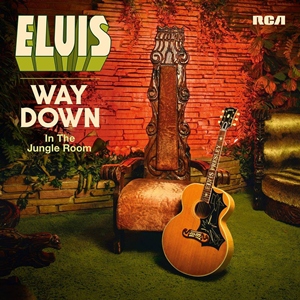 |
| -
|
-
|
.
|
In Australia - buy this great release for only $23 at JBHiFi click here . delivery only $1.70!
Please Do Not be ripped off by other Australian Elvis shops. |
|
'The Elvis Files Vol. 2' Book Review: 'The Elvis Files Vol. 2' 1957 – 1957 contains over 1,300 stunning photos in its 540 pages and all in quality printing. It includes every public ELVIS event in his life from "1957 to 1959", every Working Moment, with over 200 newly discovered photos, multiple interviews, all the Recording Sessions, the Gold Lame tours of 1957, the Movies: Loving You, Jailhouse Rock, King Creole are all covered in great details with lots of unseen photos. Best of all are the stunning full-page photos as well as the intricate look into Elvis' amazingly high-paced life.
There is no doubt that this is a labour of love for Norwegian Erik Lorentzen, author and long time Elvis fan, who has found a ton of images and information never before published.
And while this isn't a cheap book The Elvis Files Volume 2 is even more impressive than the first book.
(Book Reviews, Source;EIN) |
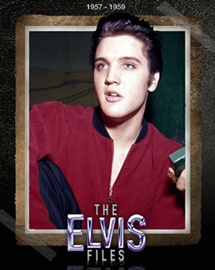 |
Feedback
Victoria Busch: Found the information on Graceland very interesting.Been an Elvis since I was about 12 I am now 54. Love to read about him.
Madeleine Georgiou: Thanks for a good overview about Graceland.
|






